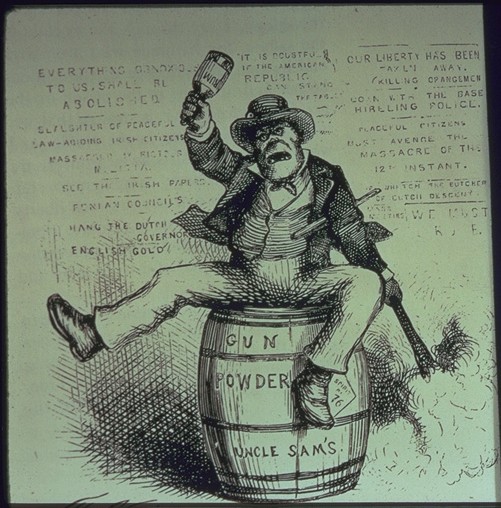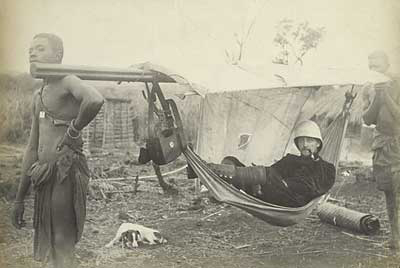Another one on
scienceness and history--I recently picked up a copy of Steven Pinker’s latest book,
The Better Angels of our Nature: Why Violence Has Declined (Pinker 2011a).
I didn’t finish it. I made through the first two chapters, flicked through the rest, and reshelved it. It was enough to convince me that reading the rest of it would not be a productive use of my time. [Edit: I did finally finish it, but I begrudge every minute I spent on it]. Life is too short for bad beer and this book is Coors Light, and at 835 pages, a 55-gallon drum of Coors Light. I don’t like calling a 800+ page book lazy, especially when I have never written a book, but somehow I feel compelled to do so. The energy that went into all that writing could have been better directed into research. A smaller book, but a better book.
To start,
Better Angels is
Whig history writ large. There is a progress and a direction to human history, of which the European and North American liberal democracies are the current highest development. Nothing new there, except that Pinker is bringing the cachet of science.
His basic argument is that violence has declined throughout human history. He has a six-part periodization—the growth of the state, the civilizing process (after
Norbert Elias), the Enlightenment, the post –WWII “Long Peace”, the end of the Cold War (post 1989) and the Universal Declaration of Human Right (post 1948). It’s an odd set of trends, what with everything piling up after WWII. Pinker’s own lifespan is when historical inevitability really starts kicking into high gear. “Panglossian” doesn’t begin to describe it. Possibly there is a brilliant argument making this case later in the book. I wouldn’t know, I didn’t read that far.
I couldn’t find where Pinker defines “violence.” And according to his
FAQ, he doesn’t, or rather he just goes with the dictionary definition, in which ”physical force is exerted for the purpose of causing damage or injury.” As an aside he notes that economic inequality is not violence--“the fact that Bill Gates has a bigger house than I do may be deplorable, but to lump it together with rape and genocide is to confuse moralization with understanding.” While his reduction of economic inequality to Bill Gates having a bigger house than Steven Pinker is jaw-droppingly callow, one can agree that economic inequality is not the same as rape and genocide. By his criteria, however, a parking lot shoving match is like rape and genocide, while slavery is not. In this light, his statement about confusing moralization with understanding is disingenuous.
The key chapter for me was Chapter 2 “The Pacification Process” where Pinker lays out the role of early states in reducing violence--the transition from the “anarchy of the hunting, gathering, and horticultural societies” to the first civilizations. (Chapter 1 is disposable—a series of scene-setting luridly violent vignettes from the standard Western Civ. timeline). Chapter 2 is key for my purposes because it is where Pinker arrays his archaeological and anthropological evidence.
Nature, culture, and the "Primordialist Fallacy"
He is also making an unusual argument for evolutionary psychology—the transition from non-state societies (which Pinker gratingly refers to as being in “a state of nature”) to state societies is the transition from biology/human nature
1 to cultural processes
2 as the driving force of history.
So, to give Pinker his due, he does not see culture as just “noise” disguising true human nature.
Better Angels is about the positive role culture (in the form of “civilization”) plays in improving the human quality of life by controlling human nature. Unfortunately, ability of humans to control their animal natures doesn’t kick in until we have militarized states. For Pinker, culture is not a factor in non-state societies—they live, after all, in “a state of nature”.
There is a popular idea that if something is older it is more basic to human nature. I am not sure if the Primordialist Fallacy is an officially-recognised fallacy, but it should be. Once we see culture, learned human behavioural variation, we need to be very cautious about identifying particular behaviours as primordial rather than cultural. Until we know better, we have no reason to believe humans 3000 years ago were more “natural” than humans 2000 years ago. It is possible, it is a topic for careful research, but it is not something we can assume. And primordial human nature is certainly not something we get at, as Pinker does, by drawing a line through state/non-state societies, with human nature on one side and culture on the other.
Hobbes/Rousseau (like you didn't know that was coming)
A convenient if rather lazy framework for writers on violence and warfare is the contrast between Hobbes and Rousseau. This contrast provides a tidy narrative and easily defined villains. Pinker finds the lure irresistible, especially given his propensity for straw-manning potential critics. So we are treated to a mysterious group of Rousseauian “anthropologists of peace” and even a “peace and harmony mafia” that persecutes dissenters.
In contrast to Pinker’s Hobbes/Rousseau dichotomy (which, to be fair, he inherited from other authors, particularly Lawrence Keeley and Azar Gat) the mainstream anthropological take is that human violence is a complex and variable phenomenon, and that the prehistoric evidence is spotty and inadequate, no matter what you are arguing. The evidence is sufficient to say that incidents of violence existed somewhere in the world at certain times. We will no doubt keep pushing the “earliest violence” back in time as we discover more. But does this really tell us something about human nature that we didn’t already know? Humans have the capacity for violence. We know that. But if we want to talk about the scale and intensity of prehistoric violence, or make extravagant claims about its universality, then we need to do some careful research.
Pinker didn’t do this research, not really. What he did do was trawl a couple of sources (precisely two in the case of the archaeology) for numbers (any numbers) that might support his thesis, no matter how ludicrous they might be. For example, in later chapters, Pinker’s sources and numbers for the An Lushan revolt (a death rate he claims that amounted to 1/6 of the world’s population) have set off some sniggering on the internet (
Quodlibeta:
Steven Pinker and the An Lushan Revolt) and even on the staid (and awesome) BBC 4 radio show
In Our Time. It’s not enough to just have a number. You need to be aware of how that number was generated and why it was generated.
Where we have good chronological control we can see temporal variations through time and by region (e.g., Lambert 2002). No surprise there. For example, where we usually have lack of evidence for violence, it is either in the Palaeolithic and Mesolithic, among “simple” hunter-gatherers, or bands. The relative lack of inter-group violence among bands is true ethnographically as well (Fry 2007). The spottiness of evidence for violence in the Paleolithic/Mesolithic is certainly in part due to the nature of the evidence—since we don’t have settlements and fortifications we must rely on skeletal evidence and some rock art. Even just considering the skeletal evidence, we can see regional and chronological variations. Some regions, such as Portugal, seem relatively peaceful, while others, such as Scandinavia, appear violent (Thorpe 2003; 2005).
In Chapter 2, Pinker’s primary evidence is presented in a chart (Figure 2-2) that supposedly shows the decline of human violence from non-state to state societies. He divides the chart in prehistoric (archaeological) non-state, ethnographic non-state, and (presumably) "state" societies. The chart is available in Google Books, but a version is also presented in an Edge talk Pinker gave, which is the one I have used here.
Pinker arranged the data in this chart to give an impression of declining violence, presumably through time, although we are not sure quite what the X axis represents beyond “Non-comparable things Pinker is comparing”. There is no particular reason not to arrange them the way he did, but it does serve to wash out variation, to make a complex situation very neat. I think this probably has something to do with unease evolutionary psychologists have with human variation. They are, after all, in pursuit of a cultureless (i.e., invariant) human nature.
In the following graphic I have arranged same data roughly chronologically and roughly geographically. It no longer looks so neat. Now we see hints of regional variation and sudden wild spikes in violence that might indicate exceptional events, such as wars and battles. I will be drilling down on this chart in a future post. There is so much wrong with it that it requires its own post.
Conceptual problems with comparing state/non-state violence
The evidence we have indicates violence varies geographically and temporally. That makes a simple direct comparison between state and non-state societies a problem. It seems to be a true observation that states are less violent internally. Elites do have an interest in maintaining a monopoly on violence within the state. But also states operate on different spatial principles than non-state societies. In many non-state societies, every group is “on the front line” simply because there is no front-line. States concentrate violence on their borders, at least if the state is not in crisis.
1) So if you want to look at the violence of states as measured by death rates, you do not look within the state, you look at the borders and beyond. We must consider that sometimes a high death rate within a society is not because that society is inherently violent, but because they had neighbours who were inherently violent. Non-state societies on the borders of states usually experience high rates of violence. That rate of violence is not because they are a non-state society, but because they border a state society. They will have a high death rate and the state society will have a low death rate. States can build up high population densities in areas of low violence. Non-state societies cannot do this so easily, especially when confronted with a state.
For example, Pinker uses the US in 2005 in the chart because it was one of the countries "worst years for war in decades, with the armed forces embroiled in conflicts in Iraq and Afghanistan. Together the two wars killed 945 Americans, amounting to 0.0004 (four hundredths of a percent ) of American deaths that year" (Pinker 2011). As an example of the US' lack of violence, this rather misses the point. The violence in Iraq in Afghanistan falls primarily on Iraqis and Afghanis--and is caused by the US state. Pinker is looking in the wrong place.
2) Beyond the historical consideration of who is “delivering” the high death rate, there is also the question of comparability. Violence in non-state societies is “decentralized”, diffuse, and dispersed through out the society. Everyone has a roughly equal chance of death by violence. States concentrate violence and are capable of delivering it on a massive scale in a geographically limited area. They “project power” to use the lingo. In essence the geography of violence in states is unevenly distributed. The violence of states is not reflected by the death rate within states.
3) Violence in states is also bureaucratized. The people who commit the physical act of violence are relatively few but are backed up by often quite massive organizations dedicated to ensuring that that act of violence happens. For example, after the 3rd century, the Roman state was little than a life support system for the military, a pattern that we often see historically. What does it mean to say a state, such as Assyria or the late Roman Empire is less violent than a non-state society? Is the dictionary definition of violence really an adequate metric?
I admire “Big History” and we need more of it. I, however, don’t do it and I never will. I work at the academic coalface. I generate data more than synthesize it, and have to struggle to link archaeological data to broader archaeological and historical issues. I know my specialty within archaeology, and get uneasy when I am too far from it. So I don’t have then panache, the devil-may-care disregard for…oh…the niceties of clean comparable data sets that sweeping historical syntheses take. Nor do I have the time. But I see the need for big comparative studies, and accept that the data is going to be rough. Otherwise we just stay mired in the small stuff. But to pull it off you need to do so....much...work. It is not sufficient to grab other people’s data (i.e. numbers) out of context and shovel them into an ideological hopper without any effort to understand what those numbers represent, and, more to the point, what the potential problems might be. You need to know what you are doing and you need to know what your data represents. There is a fine line between devil-may-care and not giving a damn. Pinker doesn’t merely cross that line--he soars over it with an indifference that is almost majestic.
-------------------------------------------------------------------
1The relevant components of human nature are five “demons” (instrumental violence, dominance, revenge, sadism, and ideology (ideology?), and four “better angels”— Empathy, self-control, a moral sense, and reason.
2The cultural/civilizational forces are a bit of a grab bag (1) Leviathan— the state, with its monopoly of force and legal systems, (2) Commerce— which, as we all know, is a “positive sum game” which expands circles of interes, (3) Feminization— an odd one, but it wouldn’t be proper evolutionary psychology without it. It is the growing influence of female nature on violent male culture, (4) Cosmopolitanism—the expanding awareness of other cultures,nations, peoples, etc. through literacy and mass media, and (5) The escalator of reason— the “intensifying application of knowledge and reason to human affairs”
--------------------------------------------
References Cited
Fry, Douglas P.
2007
Beyond War: The Human Potential for Peace. New York , NY, Oxford University Press, USA.
Gat, Azar
2008
War in Human Civilization. Oxford, UK, Oxford University Press.
Keeley, Lawrence H.
1997
War Before Civilization. Oxford, UK, Oxford University Press.
Lambert, Patricia M.
2002 The Archaeology of War: A North American Perspective.
Journal of Archaeological Research 10(3):207–241.
Pinker, Steven
2011a
The Better Angels of Our Nature: Why Violence Has Declined. Viking, New York, NY
2011b
A History Of Violence Edge Master Class 2011 | Conversation | Edge.
Thorpe, I. J.N.
2003 Anthropology, Archaeology, and the Origin of Warfare.
World Archaeology 35(1):145–165.
2005 The ancient origins of warfare and violence. In
Warfare, violence and slavery in prehistory : proceedings of a Prehistoric Society conference at Sheffield University, Michael Parker Pearson and I. J. N. Thorpe, editors, pp. 1–18. Oxford, UK, Archaeopress.










